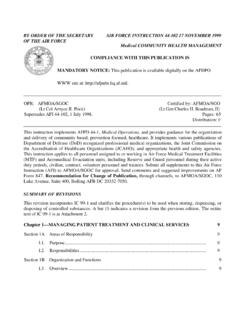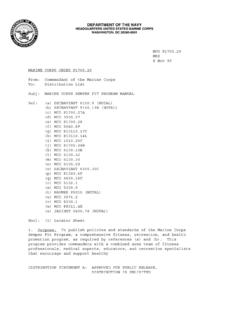Transcription of BY ORDER OF THE AIR FORCE INSTRUCTION 40-102 …
1 BY ORDER OF THE AIR FORCE INSTRUCTION 40-102 . SECRETARY OF THE AIR FORCE 3 JUNE 2002. Medical Command TOBACCO USE IN THE AIR FORCE . COMPLIANCE WITH THIS PUBLICATION IS MANDATORY. NOTICE: This publication is available digitally on the AFDPO WWW site at: OPR: HQ AFMOA/SGZP Certified by: HQ AFMOA/CC. (Lt Col Bruce E. Weaver) (Brig Gen Gary H. Murray). Supersedes AFI 40-102 , 1 August 1998. Pages: 6. Distribution: F. This INSTRUCTION implements AFPD 40-1, Health Promotion, and establishes procedures to control tobacco use in Air FORCE buildings, facilities, vehicles, and aircraft. It also implements DoD Directive , Health Promotion, March 11, 1986, and DoD INSTRUCTION , Smoke-Free DoD Facilities, January 2, 2001. It does not supersede or cancel other instructions that control smoking because of fire, explosive, or other safety hazards. SUMMARY OF REVISIONS. This updates the publication to add counseling and referral of patients to health promotion personnel by Primary Care Manager (PCM) Team members (paragraphs ); reflects the 3-year phase-in period which allows self-identified recreational Services facilities to enclose and exhaust smoking areas directly to the outside (paragraphs and 6.)
2 ; clarifies PME and formal training school instructor and staff use of tobacco products during school duty hours (paragraph ); drops the requirement of a 12-month follow-up for tobacco cessation programs (paragraph ). 1. Functional Area Responsibilities. HQ USAF. HQ USAF/CC. The Chief of Staff provides guidance on the use of tobacco products (spit tobacco, defined by the Center for Disease Control and Prevention [CDC] to be loose tobacco used by dippers and chewers ) and all types of smoking tobacco, to include cigars in Air FORCE facilities. HQ USAF/SG. The Surgeon General is responsible for mission support of tobacco cessa- tion programs. 2 afi40 -102 3 JUNE 2002. Installations and Units. Installation commanders enforce policies on the use of tobacco products. Medical treatment facility commanders (MTF/CC) ensure tobacco product cessation classes are provided to active duty members, family members, and retirees. Cessation classes are also made available to employees of the federal government on a space available basis.
3 Medical care providers ask individuals about tobacco use history at every encounter; Dental care providers ask individuals about tobacco use history at every annual examination, as a mini- mum. Medical and dental providers and/or Primary Care Manager (PCM) Team members will fur- nish pertinent professional advice to every tobacco user, using the guidelines in the Smoking Cessation Clinical Practice Guideline (AHCPR Pub # 96-0692) published by the US Department of Health and Human Services. For those individuals desiring a cessation program, providers and PCM Teams will facilitate referrals to health promotion personnel. 2. Program Elements. Tobacco Use. The Air FORCE discourages the use of all tobacco products; The ill effects of tobacco use are well documented. Workplace. The Air FORCE prohibits smoking (cigar, cigarette, pipe) and the use of smokeless (spit/loose tobacco) products in the workplace to protect the health of all workers. The use of tobacco products is permitted only in designated tobacco use areas.
4 The Air FORCE recognizes equal work breaks (when these breaks are permitted) for tobacco users and non-tobacco users. The Air FORCE prohibits indoor tobacco use in all Air FORCE facilities, except in assigned government housing and recreation facilities specifically designated by the installation com- mander permitting indoor tobacco use. In such cases, the tobacco use area is designated and sepa- rate from common areas that non-smokers must utilize and the area must be enclosed and exhausted directly to the outside. Exhaust from these enclosed areas must be located away from air intakes and maintained under negative pressure sufficient to contain tobacco smoke in the des- ignated area. Workforce must not be required to enter such areas during normal business hours while environmental tobacco smoke (ETS) is present. The designated indoor tobacco use area may not be a public, common-use area, such as: restrooms, hallways, stairways, or offices. Installation commanders are encouraged to limit the size of these areas.
5 Tobacco use is prohibited in recreation facilities offering programs that are oriented toward children. Additionally, tobacco use is prohibited in all other recreation facilities during children's programs. The Air FORCE prohibits tobacco use in Air FORCE vehicles by all personnel, civilian or mil- itary. The Air FORCE prohibits tobacco use in medical treatment facilities (MTF). Patients using tobacco must do so only in a designated area and must have the attending (or PCM) provider's written ORDER . The Air FORCE prohibits tobacco use on Air FORCE or contract aircraft. afi40 -102 3 JUNE 2002 3. The Air FORCE prohibits students from using tobacco in any professional military education (PME) or formal training school during school duty hours. Instructors and staff of PME and for- mal training courses are strongly encouraged to refrain from use of tobacco products and must be away from student view if using tobacco products during school duty hours. Points of ingress and/or egress ( doors) to facilities, in addition to windows and air intake units/vents, are considered part of the workplace for the purpose of this INSTRUCTION .
6 Any designated tobacco use areas will be away from these points. Tobacco use area distance must be more than sufficient so as not to allow smoke to be drawn into the building through openings in doors, windows, and/or air intake units. When possible, installation and/or squadron commanders designate outdoor tobacco use areas, which are reasonably accessible to employees and provide some protection from the ele- ments. Installation commanders ensure that all smoking areas are marked with signs: Designated Tobacco Use Area. Butt cans and receptacles are located only in the designated outdoor area and away from doorways or vestibules. Only fire, explosives, or safety hazard areas require No Smoking signs. Government housing does not require "Designated Tobacco Use Area" signs. Sale of Tobacco. The Air FORCE prohibits the sale of tobacco products in medical treatment facil- ities. The sale of tobacco from vending machines is strictly prohibited on Air FORCE installations.
7 No tobacco products are sold on the installation to anyone under the age of 18 years. Advertisement of Tobacco. The Air FORCE prohibits advertisements for tobacco products in all official Air FORCE publications. The distribution of tobacco samples on the installation is prohibited. Smoking in Dormitory and Housing Facilities. The Air FORCE does not house smokers and non-smokers together, in the same room or adjoining rooms, in dormitory facilities. Note: All Air FORCE lodging common areas and guest rooms, including Temporary Lodging Facility units, are now no-smoking areas per AFI 34-246, para , Air FORCE Lodging Program, May 17, 2001. Smoking is prohibited in all common areas of dormitory facilities and family housing. Smoking is allowed only in rooms designated for smokers. If a smoker is assigned a non-smoking room, smoking will not be permitted in the room. If the smoke or odor from tobacco seeps from a smoking room into common areas or non- smoking rooms, the rights of the nonsmoker will prevail.
8 Commanders may designate areas or buildings in dormitories or family housing smoke-free where there is a common air handling unit for multiple individuals or families ( dormitories, stairwell housing, etc.) to ensure a healthy and safe environment for all residents. When an area or building is designated smoke-free, provisions must be made to reasonably accommodate the smoker, an area or building designated for smoking. Education Programs. 4 afi40 -102 3 JUNE 2002. Health promotion personnel ensure installation health promotion programs (to include health promotion personnel in ANG units) incorporate education programs and information on resources available in the community to discourage tobacco use. Tobacco use risk education is provided at all work sites where the respiratory system has been identified as a target of occupational risk. Medical and dental providers and PCM Team members inquire about the individual's tobacco use history during medical and dental appointments.
9 All tobacco users receive profes- sional information about the risks of tobacco use and, if desired, assistance and/or referral for ces- sation programs. Using the Stages of Change behavioral model, tobacco cessation participants are evalu- ated on their readiness to change. Emphasis for cessation is for those identified in contemplation . or preparation stages. Tobacco cessation programs incorporate cognitive and behavior change strategies, the cold turkey approach, or the use of nicotine replacement therapy when appropriate. Professionals with a background in behavior change therapies have consultational oversight of the program structure. The MTF/CC appoints a provider from the MTF as the POC to assess appropriateness of nicotine replacement therapy, contraindications for use, and prescribes therapy as needed. The MTF/CC ensures that tobacco cessation programs are available during both duty hours and non-duty hours at least quarterly. Health promotion personnel ensure evaluation of program success through follow-up sur- veys administered six months after tobacco use has stopped.
10 3. Application to Civilian Employees of the Federal Government. Guidance on local implementation of tobacco use conforms to applicable local bargaining agreements. Local bargaining obligations must be satisfied prior to implementation. Address any concerns about this policy to the local Labor Relations Officer. 4. Application to Contractor Employees and other Non-DoD Personnel. This INSTRUCTION applies to all contractor employees and other non-DoD personnel on Air FORCE facilities and in Air FORCE buildings, vehicles, and aircraft. 5. Tobacco Use Measurement. Fitness Assessment Monitors query members about tobacco use at the time of their fitness evaluation. Health promotion personnel review and track installation tobacco use data and use it to guide implementation of programs. 6. Phase-In Period For Services Facilities. Other than those recreational Services facilities that sponsor children's programs, all other recreational facilities will be given a 3-year phase-in period that ends 7 Dec 02 to implement renovations and procure equipment necessary to meet the requirements in subparagraph At the end of this 3-year period, any facility that has not completed the modifications necessary to afi40 -102 3 JUNE 2002 5.





